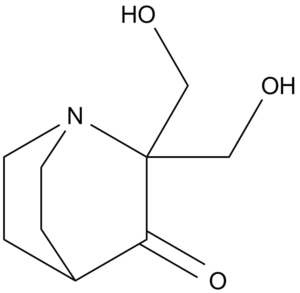This product is for research use only, not for human use. We do not sell to patients.

| Size | Price | Stock |
|---|---|---|
| 250mg | $629 | Check With Us |
| 500mg | $899 | Check With Us |
| 1g | $1345 | Check With Us |
Cat #: V2658 CAS #: 5608-24-2 Purity ≥ 98%
Description: PRIMA-1 [also known as Prima-1; chemcial name, 2,2-Bis(hydroxymethyl)-3-quinuclidinone], a novel and potent small molecule compound which is the active form of APR-246 (also known as PRIMA-1MET), is a mutant p53 reactivator which induces apoptosis and inhibits growth of human tumors.
Publications Citing InvivoChem Products
Product Promise

- Physicochemical and Storage Information
- Protocol
- Related Biological Data
- Stock Solution Preparation
- Quality Control Documentation
| Molecular Weight (MW) | 185.22 |
|---|---|
| Molecular Formula | C9H15NO3 |
| CAS No. | 5608-24-2 |
| Storage | -20℃ for 3 years in powder formr |
| -80℃ for 2 years in solvent | |
| Solubility In Vitro | DMSO: 37 mg/mL (199.8 mM)r |
| Water: 37 mg/mL (199.8 mM)r | |
| Ethanol: N/A | |
| Solubility In Vivo | Prima 1; Prima1; Prima-1 |
| SMILES Code | O=C1C(CO)(CO)N2CCC1CC2 |
| Synonyms | 2,2-Bis(hydroxymethyl)-3-quinuclidinone |
| Protocol | In Vitro | The cell lines are cultured in the presence of PRIMA-1 (NSC-281668) at 0-140 μM. The IC50s are 35, 40, 50, 50, 60, 70 and 75 μM for PANC-1, HEC-1-B, SUM149, AN 3CA, Ishikawa, Panc02 and MDA-MB-231 cells, respectively. |
|---|---|---|
| In Vivo | PRIMA-1 (Prima-1) is a p53-modulating agent. 150 or 300 ppm PRIMA-1 significantly suppresses (P<0.0001) lung adenocarcinoma formation by 56% and 62%, respectively, after 17 weeks and 39% and 56%, respectively, after 34 weeks. Administration of 150 or 300 ppm PRIMA-1 significantly suppresses NNK-induced total lung adenocarcinoma formation by 57% or 62% (P<0.0001), respectively, after 17 weeks of exposure and by 39% or 56% (P<0.0001), respectively, after 34 weeks of exposure. As with administration of the lower (50 ppm) dose of CP-31398, administration of the lower (150 ppm) dose of PRIMA-1also slightly increases the number of NNK-induced lung adenomas. | |
| Animal model | SCID mice |
| Solvent volume to be added | Mass (the weight of a compound) | |||
|---|---|---|---|---|
| Mother liquor concentration | 1mg | 5mg | 10mg | 20mg |
| 1mM | 5.3990 mL | 26.9949 mL | 53.9898 mL | 107.9797 mL |
| 5mM | 1.0798 mL | 5.3990 mL | 10.7980 mL | 21.5959 mL |
| 10mM | 0.5399 mL | 2.6995 mL | 5.3990 mL | 10.7980 mL |
| 20mM | 0.2699 mL | 1.3497 mL | 2.6995 mL | 5.3990 mL |
This equation is commonly abbreviated as: C1 V1 = C2 V2
- (1) Please be sure that the solution is clear before the addition of next solvent. Dissolution methods like vortex, ultrasound or warming and heat may be used to aid dissolving.
- (2) Be sure to add the solvent(s) in order.




































